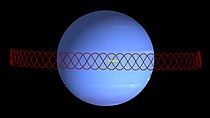Thalassa (moon)
- 0.21 ± 0.02° (to Neptune equator)
- 0.21° (to local Laplace plane)
Thalassa /θəˈlæsə/, also known as Neptune IV, is the second-innermost satellite of Neptune. Thalassa was named after sea goddess Thalassa, a daughter of Aether and Hemera from Greek mythology. "Thalassa" is also the Greek word for "sea".
Discovery
Thalassa was discovered sometime before mid-September 1989 from the images taken by the Voyager 2 probe. It was given the temporary designation S/1989 N 5.[9] The discovery was announced (IAUC 4867) on 29 September 1989, and mentions "25 frames taken over 11 days", implying a discovery date of sometime before 18 September. The name was given on 16 September 1991.[10]
Physical properties
Thalassa is irregularly shaped. It is likely that it is a rubble pile re-accreted from fragments of Neptune's original satellites, which were smashed up by perturbations from Triton soon after that moon's capture into a very eccentric initial orbit.[11] Unusually for irregular bodies, it appears to be roughly disk-shaped.
Orbit

Since the Thalassian orbit is below Neptune's synchronous orbit radius, it is slowly spiralling inward due to tidal deceleration and may eventually impact Neptune's atmosphere, or break up into a planetary ring upon passing its Roche limit due to tidal stretching. Relatively soon after, the spreading debris may impinge upon Despina's orbit.
Thalassa is currently in a 69:73 orbital resonance with the innermost moon, Naiad, in a "dance of avoidance". As it orbits Neptune, the more inclined Naiad successively passes Thalassa twice from above and then twice from below, in a cycle that repeats every ~21.5 Earth days. The two moons are about 3540 km apart when they pass each other. Although their orbital radii differ by only 1850 km, Naiad swings ~2800 km above or below Thalassa's orbital plane at closest approach. Thus this resonance, like many such orbital correlations, stabilizes the orbits by maximizing separation at conjunction. However, the role of Naiad's nearly 5° orbital inclination in this avoidance in a situation where eccentricities are minimal is unusual.[12][7]
References
- ^ Planet Neptune Data http://www.princeton.edu/~willman/planetary_systems/Sol/Neptune/
- ^ "thalassal". Oxford English Dictionary (Online ed.). Oxford University Press. (Subscription or participating institution membership required.)
- ^ The complete poetical works of Robert Browning (1912)
- ^ Jacobson, R. A.; Owen, W. M. Jr. (2004). "The orbits of the inner Neptunian satellites from Voyager, Earthbased, and Hubble Space Telescope observations". Astronomical Journal. 128 (3): 1412–1417. Bibcode:2004AJ....128.1412J. doi:10.1086/423037.
- ^ Showalter, M. R.; de Pater, I.; Lissauer, J. J.; French, R. S. (2019). "The seventh inner moon of Neptune" (PDF). Nature. 566 (7744): 350–353. Bibcode:2019Natur.566..350S. doi:10.1038/s41586-019-0909-9. PMC 6424524. PMID 30787452.
- ^ a b c Karkoschka, E. (2003). "Sizes, shapes, and albedos of the inner satellites of Neptune". Icarus. 162 (2): 400–407. Bibcode:2003Icar..162..400K. doi:10.1016/S0019-1035(03)00002-2.
- ^ a b Brozović, M.; Showalter, M. R.; Jacobson, R. A.; French, R. S.; Lissauer, J. J.; de Pater, I. (October 31, 2019). "Orbits and resonances of the regular moons of Neptune". Icarus. 338 (2): 113462. arXiv:1910.13612. Bibcode:2020Icar..33813462B. doi:10.1016/j.icarus.2019.113462. S2CID 204960799.
- ^ a b "Planetary Satellite Physical Parameters". JPL (Solar System Dynamics). 2010-10-18. Retrieved November 15, 2019.
- ^ Green, D. W. E. (September 29, 1989). "Neptune". IAU Circular. 4867. Retrieved 2011-10-26.
- ^ Marsden, B. G. (September 16, 1991). "Satellites of Saturn and Neptune". IAU Circular. 5347. Retrieved October 26, 2011.
- ^ Banfield, D.; Murray, N. (October 1992). "A dynamical history of the inner Neptunian satellites". Icarus. 99 (2): 390–401. Bibcode:1992Icar...99..390B. doi:10.1016/0019-1035(92)90155-Z.
- ^ "NASA Finds Neptune Moons Locked in 'Dance of Avoidance'". Jet Propulsion Laboratory. November 14, 2019. Retrieved November 15, 2019.
External links

- Thalassa Profile by NASA's Solar System Exploration
- Neptune's Known Satellites (by Scott S. Sheppard)
- Neptune Moon Dance (animation) on YouTube from NASA Jet Propulsion Laboratory
- v
- t
- e
- Naiad
- Thalassa
- Despina
- Galatea
- Larissa
- Hippocamp
- Proteus
| Triton |
|
|---|---|
| Prograde |
|
| Retrograde |
|
 Category
Category Portal
Portal

















